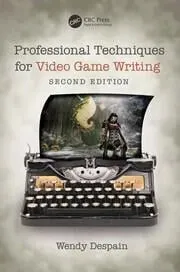Video game writing is evolving into a dynamic and respected form of storytelling, merging interactive elements with rich narratives in ways that traditional literature often cannot. As novelists increasingly venture into the realm of writing for games, they bring their unique storytelling prowess into the world of narrative design, creating experiences that captivate players and readers alike. This cross-media writing not only enriches the gaming landscape but allows for unprecedented experimentation within video game narrative. In an age where stories are more than just read, but lived, the collaboration between novelists and game writers blurs the lines between literature and interactive entertainment. With the gaming industry becoming a viable canvas for authors, the craft of video game writing is garnering the recognition it rightfully deserves, bridging the gap between text and play.
The art of crafting stories within video games has become a pivotal aspect of modern storytelling, appealing to both creators and players. Known as narrative design, this discipline encapsulates the exciting blend of scriptwriting, character development, and player choice, drawing from diverse influences like traditional novelistic techniques and innovative game mechanics. Cross-disciplinary approaches allow authors to explore new avenues in narrative, transforming the gaming experience into a multifaceted dialogue with the audience. The rising trend of authors transitioning to interactive storytelling demonstrates a shift in how narratives are consumed and created, highlighting a richer connection between video games and literary traditions. As writers harness the power of interactivity, the future of immersive storytelling in games promises to redefine how narratives engage with players.
The Interconnected Worlds of Novelists and Game Writers
The line between novelists and video game writers is becoming increasingly blurred as creative professionals navigate the complexities of both mediums. As more authors explore the realm of video game writing, they bring a wealth of narrative depth and character development to the gaming landscape. This crossover not only highlights the synergies between storytelling in literature and interactive narratives but also emphasizes the evolving nature of creative writing in a digital age. Writers find that skills honed in crafting novels can be transferred to games, enriching the player experience through well-designed narratives and immersive worlds.
However, this intersection of novelistic and video game writing raises intriguing questions about artistic integrity and the impact of different storytelling methods. Writers like Mallory Marlowe illustrate how the financial incentives of game design can complement the often unstable income from novel writing. This economic reality encourages many authors to venture into writing for games, thus fostering a creative environment where narrative design can flourish in both sectors. The profession is continually adapting, with narrative designers recognizing the potential to influence and innovate storytelling under the pressures of game development.
Understanding Narrative Design in Video Games
Narrative design is a cornerstone of video game writing, blending storytelling with interactive elements unique to the medium. Writers must craft engaging narratives that not only resonate with players but also accommodate the non-linear paths that gamers often take. Unlike novels where the reader’s experience is linear, the interactive nature of games demands that writers adapt their narratives to respond to numerous player choices, ensuring that every decision can lead to a vastly different outcome. This requires a deep understanding of both character motivation and gameplay mechanics.
Moreover, the collaborative nature of games often means that narrative designers work closely with developers and artists to create a cohesive experience. This partnership can lead to innovative storytelling techniques that push the boundaries of traditional narrative forms. Through cross-media writing, the insights gained from writing novels can enhance the depth of video game narratives, bringing a literary quality to gameplay that attracts a broader audience. The ability to navigate these diverse storytelling landscapes is what continuously attracts novelists to the world of game writing.
Exploring Cross-Media Writing Opportunities
The trend of cross-media writing has gained traction among modern creators, allowing novelists to effectively expand their narratives into video games. This practice not only provides additional revenue but also offers new platforms for storytelling that can reach different audiences. Writers like Jon Ingold show that authoring narratives in games can deepen the worldbuilding process, allowing for a richer exploration of themes and characters. The ability to take characters from prose into interactive settings creates a fresh narrative experience, enabling authors to engage with their audiences in unprecedented ways.
As video games evolve, their narrative complexity increases, which in turn offers novelists an opportunity to experiment with storytelling techniques. By incorporating their narratives into games, authors can explore the mechanics of choice, consequence, and player agency while simultaneously maintaining the depth and emotional resonance found in novels. This synthesis enriches both mediums and establishes new standards for storytelling in a digital context, showcasing the dynamic relationship between literature and interactive media.
The Changing Perception of Video Game Writing
Historically, video game writing has been undervalued compared to traditional forms of literature, often viewed as a lesser art form. This sentiment is gradually shifting as more industry professionals begin to recognize the complexity and creativity involved in shaping engaging narratives for games. Celebrated authors are increasingly contributing to the field, proving that video game writing requires significant skill, much like novel writing. The notable success of narrative-driven games has led to a re-examination of the cultural status of video games, hinting at a future where they gain recognition alongside literary works.
Moreover, the narrative achievements in video games are now garnering awards and critical acclaim, facilitating conversations around the legitimacy of game writing as a serious art form. As writers navigate this landscape, they advocate for the inclusion of video game narratives in academic discussions about literature and storytelling. The evolution of both industries highlights an important convergence of art, creativity, and technology, proving that the stories told in video games deserve just as much reverence and scholarly exploration as those in traditional novels.
The Challenges of Shifting Mediums: Novelist to Game Writer
The transition from novel writing to video game writing presents unique challenges that require adaptability and a willingness to embrace new creative constraints. Authors accustomed to the solitary act of novel writing may initially struggle with the collaborative nature of game development, where the narrative must align with design and programming decisions. For some, the process can feel overwhelming as they adapt to the non-linear storytelling required by games and the need to account for diverse player choices. This adjustment period is essential for nurturing a writer’s ability to think dynamically and consider the player’s experience.
Novelist-game writers often describe a learning curve when it comes to understanding game mechanics and pacing that differ significantly from traditional literature. Mallory Marlowe’s observations about the player’s varying levels of engagement underscore the importance of recognizing that not every player will interact with the narrative in the same way. Writers must craft stories that work for both the casual button-masher and the deeply invested storyteller, which can be a delicate balance to achieve. This complexity enriches the narrative design process and further strengthens the integration of literary techniques in games.
Diverse Narratives: The Role of Cultural Context in Games
Cultural context plays a vital role in shaping both video game narratives and novels, with storytellers incorporating their backgrounds and lived experiences into their work. As video game writing becomes a more recognized discipline, the medium is increasingly inclusive of narratives that reflect varied cultures and perspectives. Writers like Sharna Jackson demonstrate how incorporating multicultural elements into games can lead to unique storytelling experiences that resonate deeply with players. Creating diverse narratives expands the appeal of games, allowing for a broader range of voices and stories that can engage global audiences.
Moreover, exploring cultural nuances can enhance the emotional depth and relatability of the characters and settings in a game. Just as novelists tap into their backgrounds to connect with readers, game writers draw from their own experiences to create vivid and authentic worlds. By tackling themes of identity, community, and belonging, designers can forge connections that transcend mere gameplay. This rich tapestry of narratives not only enriches the gaming landscape but also fosters a greater appreciation for the art of storytelling across all platforms.
Writing for the Evolving Player Base
Understanding the diverse player base is essential for effective video game writing. As gaming becomes more mainstream, writers must cater to a wide range of audiences with different interests and expectations. This means recognizing that narrative structures must be flexible, accommodating those who seek a quick and fun gameplay experience, as well as those who are looking for intricate storytelling. This challenge has led writers to become more innovative, crafting game narratives that can engage multiple layers of players, regardless of their level of investment.
Game writers also recognize that player feedback plays a critical role in shaping the narrative landscape in real-time. Unlike novels, which are static once published, video games are fluid, allowing writers to adjust storylines and character arcs based on player interactions and preferences. This reactive storytelling not only enhances the immersive quality of games but also provides creators with invaluable insight into what resonates with players, forcing them to rethink traditional narrative techniques. It’s this ongoing dialogue between the audience and the creator that keeps game storytelling relevant and dynamic.
The Joy of Creative Freedom in Video Games
One of the primary joys of writing for video games is the freedom to experiment with unconventional narratives. With their relatively low cultural status, games encourage writers to push boundaries and explore innovative storytelling techniques that might not be possible in more traditional literary forms. As Harry Josephine Giles points out, video games allow for a malleable medium where creators can leverage unique mechanics to tell their stories in unexpected ways. This capability fosters a spirit of creativity that attracts novelists eager to challenge the norms of narrative construction.
Moreover, the playful nature of game design allows writers to infuse their stories with humor, complexity, and surprise. Unlike novels, where the conventions of the genre can often restrict creativity, games often have more fluid parameters, leading to fascinating hybrid narratives that blend elements of different genres. As novice players engage with these narratives, the potential for spontaneity increases, allowing both audiences and creators to share in the joy of discovery. This shared experience enriches narrative discussions and elevates the cultural significance of video games as a compelling storytelling medium.
Embracing the Future of Video Game Writing
As the video game industry continues to grow, the future of video game writing appears promising and full of potential for new audiences. The emergence of new storytelling technologies and platforms, including virtual reality and narrative-driven games, provides writers with fresh avenues to explore. By embracing these innovations, novelists are presented with opportunities to meld their craft with interactive experiences that engage players on a deeper level. This intersection opens the door to groundbreaking narratives that blend literary and gaming conventions, enriching the landscape for both writers and gamers alike.
Looking ahead, it is clear that the role of the video game writer will continue to evolve, as the industry seeks to integrate quality narratives into diverse gaming experiences. The increasing demand for compelling stories in games will attract more talented writers from the literary world, further enhancing the creative exchange between writing for games and novel writing. The future holds exciting possibilities for both mediums, where stories are not only told but actively experienced, cultivating an appreciation for the artistry of narrative design across multiple platforms.
Frequently Asked Questions
What is video game writing and how does it differ from traditional novel writing?
Video game writing involves creating narratives, dialogues, and storylines specifically for video games, integrating player choices and interactivity. Unlike traditional novel writing, which follows a linear narrative crafted by the author, video game writing often requires dynamic storytelling that adapts to players’ decisions, making each experience unique.
How do novelists transition to writing for games and what skills do they bring?
Many novelists transition to writing for games due to financial stability and the chance for creative exploration. Skills such as character development, world-building, and dialogue crafting are crucial in both fields, but video game writing also requires an understanding of interactivity, player engagement, and narrative design principles.
What role does narrative design play in video game writing?
Narrative design is a crucial aspect of video game writing, focusing on how the story is woven into gameplay. It includes structuring player choices, creating immersive worlds, and ensuring that narratives resonate with player experiences, effectively combining storytelling and gameplay mechanics.
Can video game narratives be considered on par with traditional literature?
While video game narratives are often viewed as less prestigious than traditional literature, many writers and critics argue that they offer unique storytelling opportunities. The interactive nature of games allows for deeper player engagement and emotional experiences, making video game narratives an evolving form of literature in their own right.
What are the challenges faced by writers in the video game industry?
Writers in the video game industry face several challenges, including job instability, creative constraints within team collaborations, and the need to adapt narratives to player choices. The industry’s fluctuating job market can also lead to frequent layoffs, making it a challenging field for many narrative designers.
How does cross-media writing enhance video game narratives?
Cross-media writing enriches video game narratives by allowing narratives to develop across different formats, such as novels, comics, and films. This approach can create a more expansive universe, enhancing player immersion and engagement, as seen in franchises where the story extends beyond the game itself.
What impact does player interaction have on video game writing?
Player interaction fundamentally changes the way stories are told in games, as writers must account for various pathways and outcomes based on player choices. This requires a flexible narrative structure where not all written material is guaranteed to be experienced, posing unique storytelling challenges for video game writers.
Is there a significant cultural divide between video game writing and traditional writing?
Yes, there tends to be a cultural divide where video game writing is often undervalued compared to traditional writing. Despite this, the growing recognition of video games as a legitimate storytelling medium is gradually bridging this gap, leading to a more appreciative view of narrative design in games.
Why are many novelists now considering careers in video game writing?
Many novelists are exploring video game writing due to financial incentives and opportunities for creative collaboration. As the gaming industry grows, it offers new avenues for storytelling, attracting writers looking to diversify their skills while maintaining a steady income.
What makes writing for video games a unique experience compared to novel writing?
Writing for video games involves creating narratives that must accommodate player agency, offering multiple story paths and outcomes. This contrasts with novel writing, where the author dictates the plot, making game writing a more collaborative and interactive creative process.
| Aspect | Video Game Writing | Novel Writing |
|---|---|---|
| Cultural Perception | Often seen as low-status and disposable art. | Considered a high-status cultural form. |
| Revenue Potential | One in five narrative writers laid off, prompting opportunities elsewhere. | Difficult to make a living; median income of £7,000 per year from writing. |
| Creative Process | Game writing involves writing numerous words that may not be used based on player choices. | Novel writing allows for more focused storytelling and independent creation. |
| Collaboration vs Independence | Collaboration can be rewarding but often downplays writing in design priorities. | More independence, but can lead to isolation and comparative loneliness in writing. |
| Cultural Value | Games draw creators due to their lower cultural status, allowing for experimentation. | Cultural conventions are stricter and harder to innovate within. |
Summary
Video game writing has emerged as a significant avenue for creative expression, reflecting the crossover between traditional literary forms and interactive media. As novelists increasingly turn to video game writing, they bring a fresh perspective to storytelling within games, while also enjoying the financial stability that game writing can provide. The evolving relationship between these two forms of writing is dynamic, with both offering unique challenges and rewards. This intersection continues to redefine what it means to be a writer in a rapidly changing cultural landscape.




